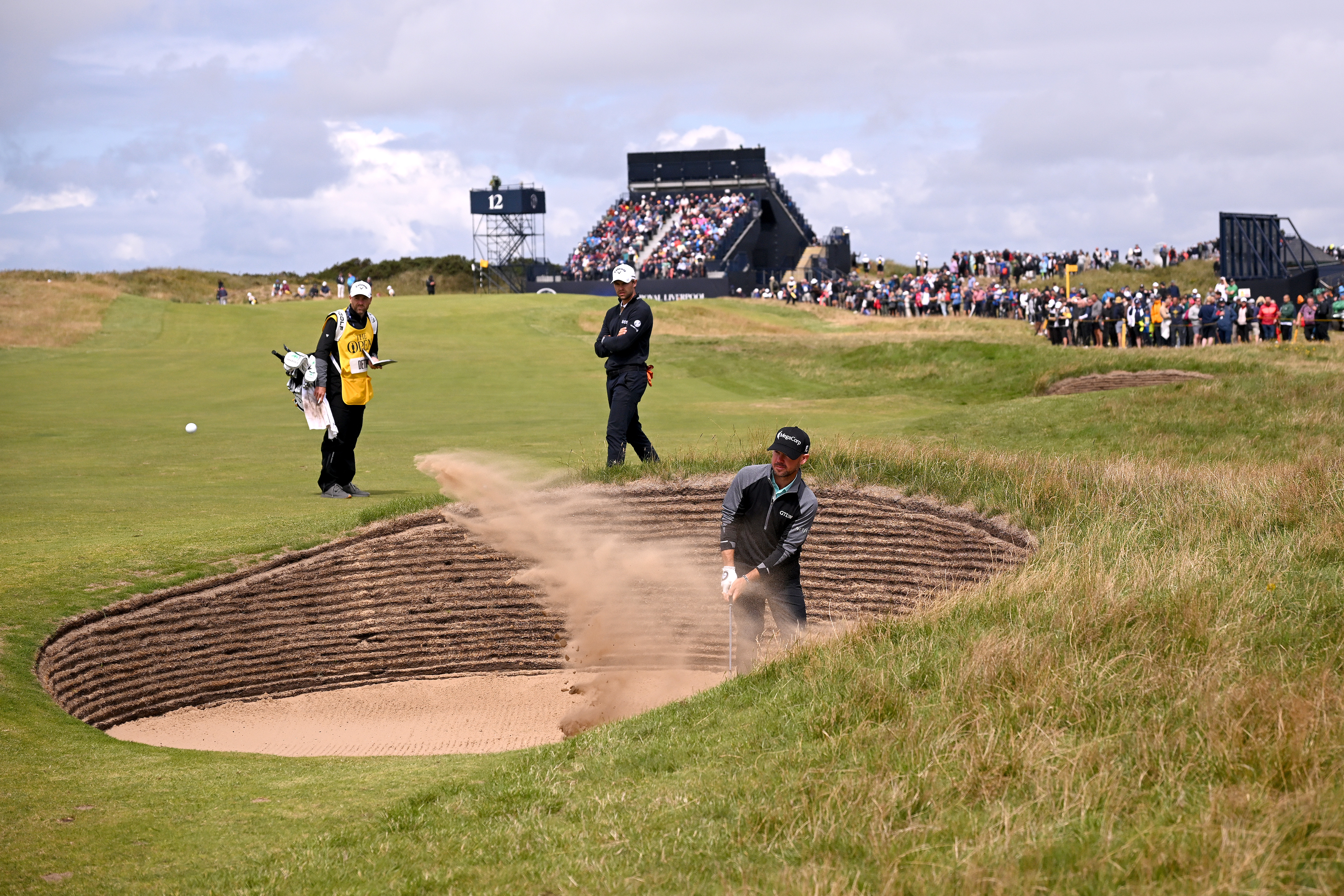HOYLAKE, England — Most of the 156 competitors in the field at the 151st Open Championship have an opinion about the 80-odd pot bunkers that litter Royal Liverpool like landmines, and few of them are effusive. The word “penal” hasn’t been used this often by a group of male jocks since autocorrect was invented thirty years ago.
Some players were sanguine about the challenges faced in the sand, including two whose misadventures on the final hole in the first round saw them either playing backward or pin-balling off the revetted sod walls.
“Proper penalty structures,” said Jon Rahm.
“You’re riding your luck,” said Rory McIlroy.
The trauma about traps owes to the fact that bunkers at Royal Liverpool aren’t maintained in a customary concave style, with sand slopes flashing up the walls to provide loft for escape and help balls roll toward the flat center of the hazard. Instead, bunker floors are flat or even slope slightly toward the walls, which are mostly perpendicular. This setup substantially increases the chances of a player finding his ball flush against the wall, or at the very least having to manufacture a body-bending stance seldom achieved by any athlete not working a balance beam.
LIVE LEADERBOARD: The Open Championship Tournament Leaderboard Scores, Schedules, Pairings and More
After multiple such occurrences on Thursday, the R&A lost its nerve and loosened the thumbscrews.
“Yesterday afternoon the bunkers dried out more than we have seen in recent weeks and that led to more balls running straight up against the face than we would normally expect,” Open organizers said in a statement Friday morning. “We have therefore raked all of the bunkers slightly differently to take the sand up one revet on the face of the bunkers. We routinely rake bunkers flat at most Open venues but decided this adjustment was appropriate in light of the drier conditions which arose yesterday.”
The timing of the change is as controversial as the change itself. Since the R&A admitted that conditions worsened during the first round, shouldn’t the same thing have been allowed to happen during the second round to ensure, as best as possible, that each side of the draw faced identical conditions? It’s almost enough to make one wish Sergio Garcia were in the field to lament injustice and favoritism.
The alteration is popular with competitors. “I hit a 4-iron into the 5th hole today and it pitched on top of the bunker and came back in,” McIlroy said, adding that he expected to find his ball against the face. “I didn’t know at this point that they’d made that little gradual rise up into the face, and when I got up there, I was pleasantly surprised that I had a shot. I wouldn’t say there’s one person in the field that wouldn’t welcome that change.”
Still, it’s tempting to wonder what a 68-year-old retiree in Japan thinks of it.
Tommy Nakajima was in contention at the 107th Open at St. Andrews in 1978 when he reached the green of the par-4 17th hole in regulation. His birdie putt caught the wrong side of a contour and fell into the infamous Road Hole bunker, a much more cavernous pit of despair then than it is today. He needed four shots to extricate himself and eventually made a nine. “The Sands of Nakajima” entered Open lore.
Nakajima didn’t bemoan the severity of the bunker or the slope that carried him to his doom. Nor did the R&A soften things for the next day’s play. He got there with the combination of a marginal shot and lousy luck, and the same is true of most shots that find the hazards at Hoylake. It’s not the function of the R&A to cushion marginal shots or mitigate bad breaks. Or it didn’t used to be. Luck cannot be legislated out of links golf. If anything, it’s the soul of the ancient game.
The PGA Tour is proud of the courses it presents every week in its feverish but futile effort to commodify conditions and eliminate unpredictability from the game. Most Tour members are grateful for that since it reduces things to a test of execution and lessens the demand for intangibles, like imagination, creativity and forbearance. The Tour will deny that is the philosophy governing its course set-up, but it’s the result.
Trying to minimize unpredictability is entirely at odds with the essence of links golf. And at the Open, fickleness encompasses everything — the weather, the bounce, the lie, even the water pressure in British showers, which in bygone years could be likened to being peed on without the warmth. Reducing the potential for cruel outcomes in bunkers diminishes the very character of the ground game.
Changes to course set-ups because of tepid player reviews are nothing new. Jack Nicklaus introduced rakes that gently furrowed bunkers at Muirfield Village in the 2006 Memorial Tournament, intent on presenting a greater challenge. Locker room griping led to the experiment being abandoned. At the 2017 U.S. Open at Erin Hills, the USGA dispatched lawnmowers to remove high fescue rough after complaints, despite the fairways being wider than Tiananmen Square.
The oldest battlefront in golf is where the desire to present a challenge meets the players’ determination to not to be embarrassed. Major championships should seek to advance that front in favor of the challenge while being careful to remain on the right side of goofy. Softening bunkers at Royal Liverpool is counter to that goal.
The R&A should simply have directed complainants to Rahm’s comment earlier this week when asked if the new 17th hole is too harsh.
“I would say if it is it’s fair, because it’s unfair to everybody,” he replied. “Like it’s golf, and it’s life. Simple as that.”

